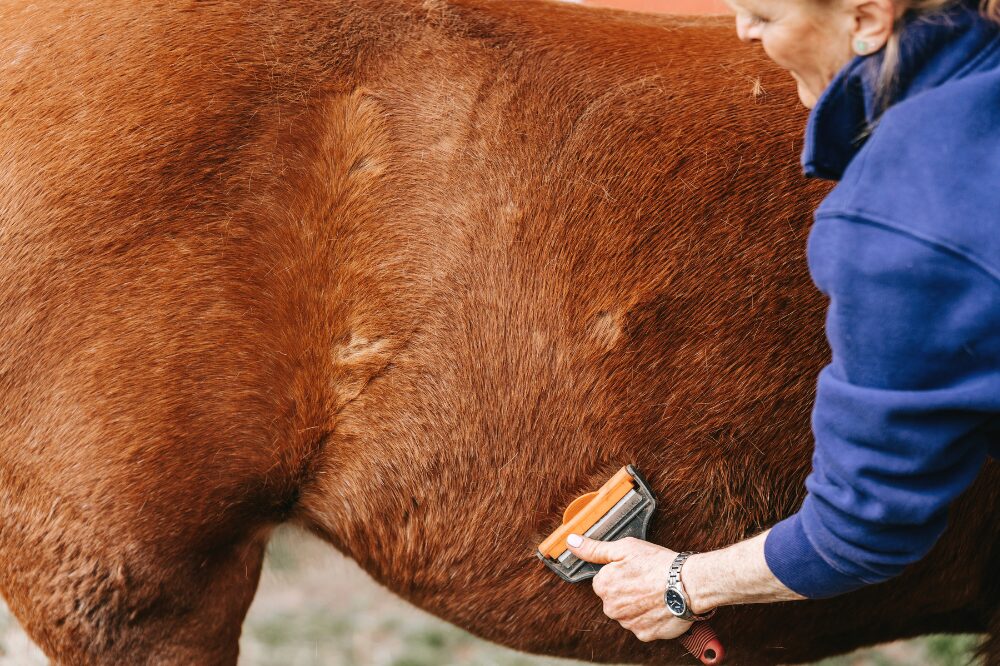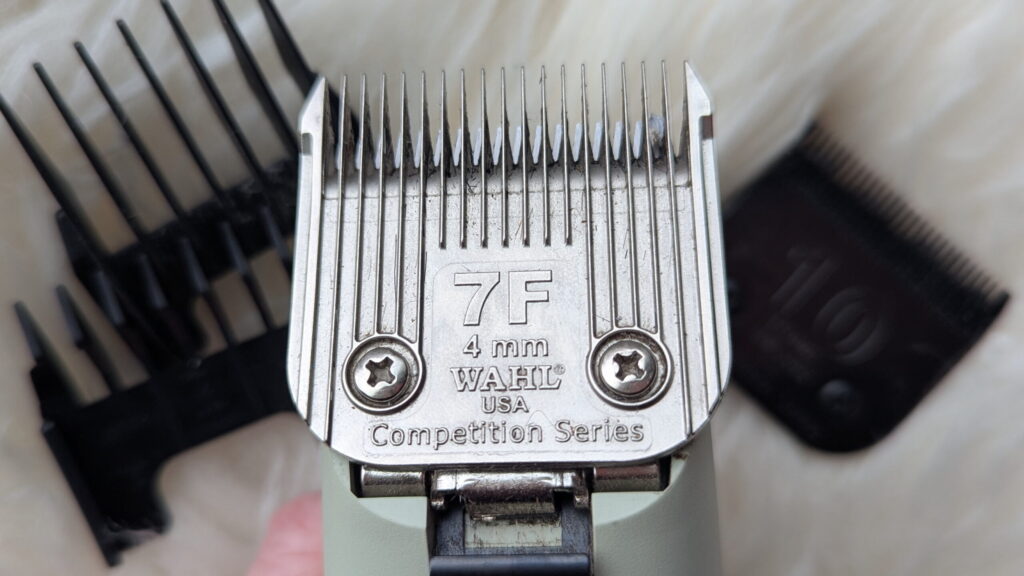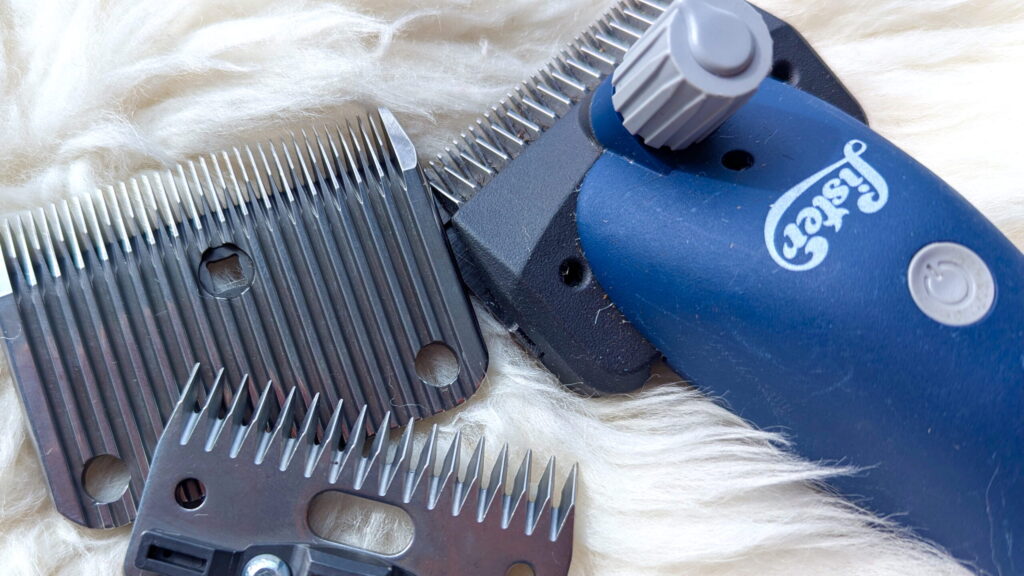Tips for Clipping a Horse with Cushing's Disease (PPID)
Horses that shed late, have crazy long hair coats because of genetics, or have thick coats due to pituitary pars intermedia dysfunction (PPID, formerly known as Cushing’s disease) need help with thermoregulation to maintain their temperature. Clipping a horse with Cushing’s, or any horse with long, thick hair, is easy with the right tools and may become a year-round event to stop them from baking.
Table of Contents

Managing The Horse or Pony With Cushing’s
- Pituitary pars intermedia dysfunction is a metabolic disorder that affects a horse’s hormones and overall metabolic health. It’s linked to long hair coats and an increased risk of laminitis, among other things.
How does Cushing’s in horses “work?”
- While most of us know the term Cushing’s disease, it’s now officially called Pituitary Pars Intermedia Dysfunction (PPID). PPID originates in your horse’s brain and creates a chain reaction of hormones.
- The pituitary gland pumps out more adrenocorticotropic hormone (ACTH) than is needed. Excessive ACTH begins the cascade of events that create complications of PPID, starting with too much of the hormone cortisol.
- Cortisol is a “stress hormone” that increases insulin levels, sometimes creating insulin resistance (IR) in your horse.
- Insulin resistance occurs as horses become less sensitive to insulin and, therefore, will produce more of it to compensate.
- The higher cortisol levels and resulting insulin levels increase the chance of laminitis, make wooly coats, and contribute to muscle and weight loss. We know a direct line exists between high insulin levels and laminitis. PPID steps on the accelerator.
- Medications, usually Prascend®, can help manage Cushing’s in horses. A low-sugar, low-starch diet can also help reduce the risk of laminitis. Use grazing muzzles while turned out to lower laminitis risks.

Shedding season gets hairy.
Cushing’s Disease Complications in Horses
- A horse with that long coat – technically called hirsutism – may be the most apparent complication. Your horse’s comfort is at stake here! Thick coats do not shed properly, and summer coats are often much thicker, creating temperature regulation struggles.
- Cortisol is a steroid and directly impacts the hair follicles of some horses. Those increased stress hormone levels pump up hair production. The result is SO MUCH HAIR – and wasted energy. Growing all that hair takes proteins and energy away from your horse’s other body needs.
- The increased risk of laminitis is a tragic complication. For many horses, an episode of laminitis is the first clue that something is going on with their metabolism.
- Cushing’s will also interfere with your horse’s immune system. Infections, hoof abscesses, and trouble fighting any pathogen are all increased.
- A note about longer hair coats: not all horses with PPID grow a longer coat, and not all horses with a longer coat have PPID. Please don’t wait for your horse’s hair to tell you about their metabolic status. Have your vet do some testing!
Tips for Clipping a Horse With Cushing’s
- While adding meds and a diet change are relatively easy, managing the thick coat can be challenging. It’s time to clip! Summer is hot, and your horse doesn’t need a wild, wooly fur jacket. Depending on your area and climate, clipping into fall and winter may be necessary, too. And spring, come to think of it.
Pick the best clippers for your horse.
- Trimmers will scream and die when merely brought in the vicinity of a full-blown Cushing’s coat situation. These smaller clippers are for touch-ups, bridle paths, and basic trimming.
- Body clippers might be OK, it depends on the coat and how powerful the clipper motor is. Body clippers may work, but clipping the horse with a dense, long Cushing’s coat won’t be easy, fast, or pretty. You need power!
Horse shears for more power
- It’s time to bust out the larger livestock-style shears. You don’t have to get the livestock blades!
- The beauty of using larger clippers is twofold. The blades are wide, so your clipping is more efficient. The clipper body and motor are also wildly powerful and can easily clip through the thickest horse coats.
- Shears can be tricky to navigate over the legs. One option is to remove the bulk of leg hair with shears. The result may not be pretty or finished! Come back with body clippers for more detailed work and fine-tuning the legs.

These shears are powerful!
Choose the best clipper blades for your horse.
- When working with the larger clippers, you will need appropriate blades. They come in two pieces; you have to screw them on your clipper body and then tension them for the best fit.
Most blades are labeled similarly between brands
- There are horse blades that give you tons of options. Most shears come with medium or fine blades that do well and leave about 1-2 mm of hair.
- Fine blades are the equivalent of a #15 blade, leaving 1.4 mm of hair on your horse. The hair will be shorter than using a #10 blade.
- Coarse and Medium blades leave 2.5 mm of hair, comparable to a #9 blade.
- Covercote blades leave 5 mm of hair and may work well in cooler weather to “take a little off the top.”
- With these options, you can pair the best blade system for your horse’s needs and the time of year.

Body clippers with a 10 Wide blade, Lister Stars, and trimmers with a 5-in-1 blade.
When should you clip a horse with Cushing’s?
Body clip or trace clip your horse when their coat doesn’t match the weather. The goal is to reduce discomfort and improve the quality of life through body clipping. For horses with PPID, this process usually requires regular clipping through all seasons.
Some signs it’s time to clip your horse:
- There is no set time, season, or month to clip your horse, regardless of their Cushing’s status. Clip your horse when they need it.
- Clip when there is unmanageable sweating, any time of year.
- Clip when your horse has trouble cooling out. Their body temperature will take longer than usual to return to normal.
- Clip when there’s a mismatch between the weather and their coat. Paying close attention to this will also influence which blade to use.
- Clip when the shedding of their winter coat is too slow for the warming temperatures.

The #7F blades leave more hair, but the teeth have room for a thicker coat.
Your horse’s skin and overall health
- Long coats and compromised immune systems go hand-in-hand with PPID. Clipping the coat allows proper drying, easier access to the skin, and helps prevent mud fever, rain rot, and other fungal and bacteria skin infections that get trapped under that hair.
- Regular clipping gives your eyes and hands more weight and body condition feedback, too. Long hair can hide a lot!
What type of clip should you do?
- You can also vary the style of body clip that you do. Generally speaking, a body clip is necessary for the warmer summer, legs and face included.
- A trace clip is helpful to even out the sweaty parts. Trace or partial clips alleviate excessive sweat and provide warmth from cool and cold weather. You may need to use sheets on chilly days.
- Otherwise, opt for a full-body clip. You can always clip all the hair and use sheets until the weather smooths out.
- In the winter, any variation of a trace clip will work well. Concentrate on the sweaty areas. Another option is a complete clipping in the fall and let some of it grow back in. Then, you can touch up with a trace clip as the weather gets cold.
- Another option is using a medium or covercote blade on your horse’s entire body in winter.
- Your horse will dictate how often he needs clipping!
General Tips for Clipping the Horse with Cushing’s
- Clipping success begins with preparation and patience. Here are some tips for clipping a PPID coat.
- Bathe and dry your horse before you begin. No good comes from running blades through dirt and dander. In cold weather, hot towel your horse before starting.
- Use a soothing shampoo for sensitive skin. There’s no need to remove stains, as those will be clipped away.
- Use sheen spray on the dry coat to make the hair slippery and sleek for the blades.
- Stay ahead of the long hair with regular clipping. As the weather turns colder, a shorter coat is easier to bathe, dry, and clip.
For body clippers
- You may need to use two different blades if you use body clippers. You could use a #7F that leaves 4 mm of hair, as the teeth are wide apart, allowing more hair to enter the blade than a #15. You could switch to a #9 or #10 to finish up.
- Remember, this is a functional clip, and the hair will smooth out over time. While it’s certainly possible to have a super sleek finish, the long hair and body clippers may not be ideally matched for a full body clip.

The cutter and comb of these shears need the perfect tension for best results.
For shears
- It’s a good habit for all clippers to stop every 5 minutes to remove hair and add more oil.
- Shears need oil along the teeth, down the sides where the cutter and comb meet, and in the little holes across the top of the clipper body. You may need to add grease, too.
- Check the tension of your shears often as you clip. Incorrect tension pulls hair, creates heat, rattles, and gives an uneven look.
- Shears are great for a fast clip that removes bulk. For a more polished look, you can tidy up with regular clippers.
Clipping a horse with Cushing’s disease is often necessary to keep them happy and comfortable. You will become a clipping expert. And don’t forget to start with a clean horse and use clipper oil every 5 minutes!
Videos
Go Shopping
Stock up here for your horse supplies! As an Amazon Associate, I earn from qualifying purchases, but it’s ZERO extra cents to you. As a Walmart Associate, I earn from qualifying purchases as part of their affiliate plan. I appreciate your support! You can also visit my Amazon storefront here: PEG storefront.
Or, take a look around SmartPak. Thank you!
These wildly powerful shears are great for thick coats, and when I say thick, I mean it.
This new KM cordless clipper has constant power, no matter the haircoat, and rechargeable batteries that last 3 hours. It's quiet, and the wide blade makes clipping faster.
For a sleek and protective finish on your horse's coat, and Magic Sheen is also great for detangling manes and tails.












